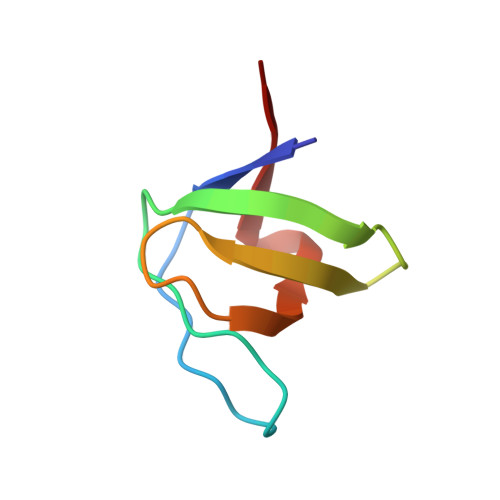RT loop flexibility enhances the specificity of Src family SH3 domains for HIV-1 Nef.
Arold, S., O'Brien, R., Franken, P., Strub, M.P., Hoh, F., Dumas, C., Ladbury, J.E.(1998) Biochemistry 37: 14683-14691
- PubMed: 9778343
- DOI: https://doi.org/10.1021/bi980989q
- Primary Citation of Related Structures:
1BU1 - PubMed Abstract:
Understanding the issue of specificity imposed in the interactions of SH3 domains has largely been addressed in studies investigating the interaction of proline-rich amino acid sequences derived from potential ligands for these domains. Although the interaction with this motif forms an essential platform in the binding of SH3 domains, in many cases little specificity is observed and the difference in affinity for so-called specific and nonspecific proline-rich sequences is not great. Furthermore, the binding interface between an SH3 domain and a protein ligand appears to encompass more interactions than are represented by that involving the proline-rich motif. Here we investigate the issue of specificity from the opposite point of view; namely, how does a ligand recognize different SH3 domains? We present the crystal structure of the unbound SH3 domain from hemopoietic cell kinase (Hck) which is a member of the Src family of tyrosine kinases. This structure reveals that, unlike the structures of other Src kinase SH3 domains, the RT loop region is highly mobile and lacks a network of hydrogen bonds that is elsewhere apparent. The RT loop has been shown to form a major part of the binding interface between SH3 domains and HIV-1 Nef. Thermodynamic data, derived from isothermal titration calorimetry, for the binding of Hck SH3 to HIV-1 Nef show that the binding of Hck (KD = 1.5 microM) is approximately an order of magnitude tighter than those of other Src family kinases that were investigated (Fyn, Lck, and Src). This increase in affinity is attributed to, among other effects, the inherent flexibility in the RT loop which does not require breaking the network of hydrogen bonds to adopt the conformation required for binding.
- Centre de Biochimie Structurale, UMR C9955 CNRS, U414 INSERM, Université Montpellier 1, France.
Organizational Affiliation:
















